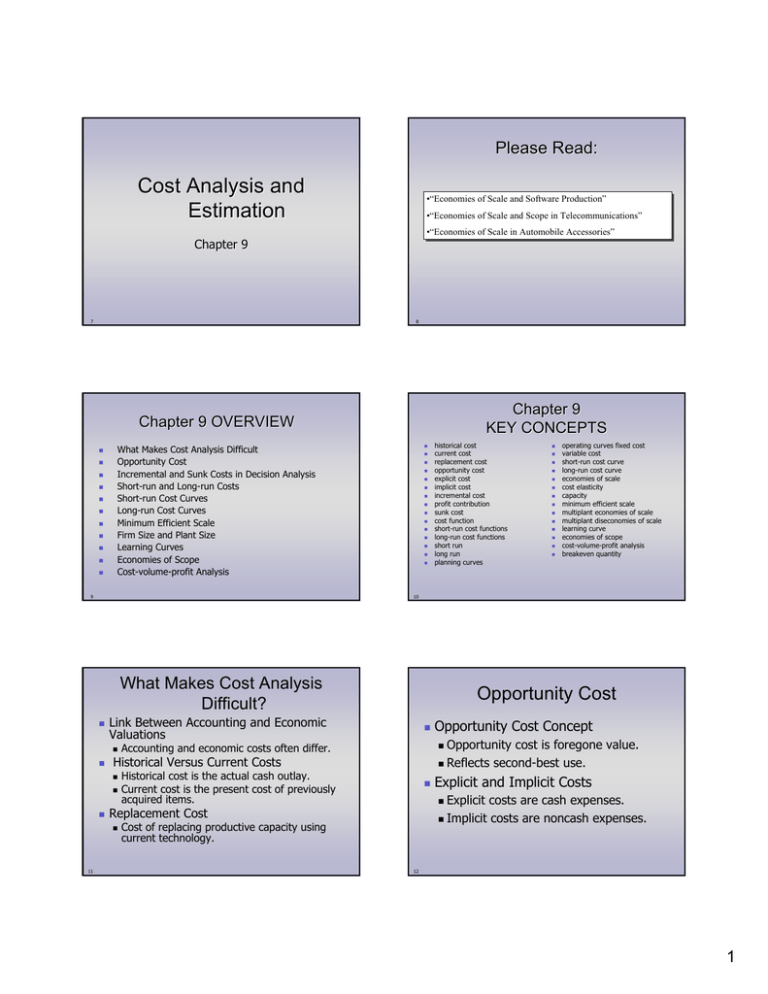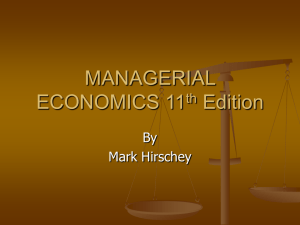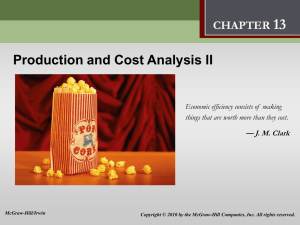Cost Analysis and Estimation Please Read:
advertisement

Please Read: Cost Analysis and Estimation •“Economies •“Economiesof ofScale Scaleand andSoftware SoftwareProduction” Production” •“Economies •“Economiesof ofScale Scaleand andScope Scopein inTelecommunications” Telecommunications” •“Economies •“Economiesof ofScale Scalein inAutomobile AutomobileAccessories” Accessories” Chapter 9 7 8 Chapter 9 KEY CONCEPTS Chapter 9 OVERVIEW What Makes Cost Analysis Difficult Opportunity Cost Incremental and Sunk Costs in Decision Analysis Short-run and Long-run Costs Short-run Cost Curves Long-run Cost Curves Minimum Efficient Scale Firm Size and Plant Size Learning Curves Economies of Scope Cost-volume-profit Analysis 9 historical cost current cost replacement cost opportunity cost explicit cost implicit cost incremental cost profit contribution sunk cost cost function short-run cost functions long-run cost functions short run long run planning curves operating curves fixed cost variable cost short-run cost curve long-run cost curve economies of scale cost elasticity capacity minimum efficient scale multiplant economies of scale multiplant diseconomies of scale learning curve economies of scope cost-volume-profit analysis breakeven quantity 10 What Makes Cost Analysis Difficult? Accounting and economic costs often differ. Historical cost is the actual cash outlay. Current cost is the present cost of previously acquired items. Cost of replacing productive capacity using current technology. Opportunity cost is foregone value. Reflects second-best use. Explicit and Implicit Costs Replacement Cost Opportunity Cost Concept Historical Versus Current Costs Opportunity Cost Link Between Accounting and Economic Valuations 11 Explicit costs are cash expenses. Implicit costs are noncash expenses. 12 1 Incremental and Sunk Costs in Decision Analysis Incremental Cost Incremental cost is the change in cost tied to a managerial decision. Incremental cost can involve multiple units of output. Short-run and Long-run Costs At least one input is fixed in the short run. All inputs are variable in the long run. Marginal cost involves a single unit of output. Sunk Cost How Is the Operating Period Defined? Fixed and Variable Costs Fixed cost is a short-run concept. All costs are variable in the long run. Irreversible expenses incurred previously. Sunk costs are irrelevant to present decisions. 13 14 Production Production and and Cost Cost Related Related II What Are Cost Functions? Constant returns to the variable input in the production function… All cost functions are a combination of two pieces of information: 1) the production function. 2) the input prices. Changes in either of these pieces of information will change the cost function. That is, cost functions get their shapes from the shape of the production function and the input prices. 15 results in a linear variable cost function 16 Production Production and and Cost Cost Related Related IIII 17 Production Production and and Cost Cost Related Related III III Decreasing returns to the variable input in the production function… Increasing returns to the variable input in the production function… results in a curvilinear variable cost function which increases at an increasing rate results in a curvilinear variable cost function which increases at an decreasing rate 18 2 Cost Curves Cost = sum of (P (Pinputs * Qinputs) Qinputs includes fixed and variable inputs Fixed Costs - sum of all Pi*Qi Pi*Qi for fixed inputs Variable Costs - sum of all Pi*Qi Pi*Qi for variable inputs 19 Short-Run Short Short-Run Cost Cost Curves Curves These Thesecost costfunctions functionsare areexactly exactly those thoseininthe the“Stack “StackDiagram.” Diagram.” Figure 9.1 20 Total Total Cost Cost Function Function for for aa Production Production System System Exhibiting Exhibiting Increasing, Increasing, Then Then Decreasing, Decreasing, Returns Returns to to Scale Scale Total Cost Total cost (TC) = TFC + TVC (vertical addition of TFC and TVC curves) Total TotalCost CostFunction Function Total TotalProduct ProductFunction Function Figure 9.2 21 22 Total Total Cost Cost Curve Curve Derived Derived Total Total Cost Cost Curve Curve Derived Derived Cost CostFunction Function Production ProductionFunction Function Production ProductionFunction Function Each Eachunit unitof of labor laborcosts costs $160 $160 24 25 3 Total Cost Curve Derived Cost CostFunction Function Variable Variablecost costcurve curve isis derived derived from fromthe the production production function function and and an an assumption assumption about about the the price price of of the the input input (labor’s (labor’s price price isis $160 $160per per unit unit in in this this example). example). Production ProductionFunction Function Quantity of Output The “Stack Diagram” Diagram” Shows the Relationship Between Production and Cost! (short(short-run) Stage III Stage II DAR Q2 DMR Q3 Q = bX + c X 2 - dX 3 • (A) • X3 X2 MP X AP X Units of Variable Input (X) X1 • • AP X = b + cX - d X 2 $ TC = a + bQ - c Q2 + d Q3 X3 X2 X1 TVC = bQ - c Q2 + d Q3 (B) Units of Variable Input (X) MP X = b + 2cX - 3d X 2 • (C) • • Q3 • TFC = a Q2 Q1 Quantity of Output MC = b - 2cQ + 3d Q2 $ ATC = a + b - cQ + d Q2 Q AVC = b - cQ + d Q2 (D) AFC = a Q Q3 26 Stage I Q1 Q2 Quantity of Output Q1 27 Marginal and Average Cost Curves Long-run Cost Curves Economies of Scale Long-run cost curves show minimum cost in an ideal environment. 28 29 The Effect of Scale (This is the Long Run!) Effect of Scale if you expect 10 customers, you will build a smaller facility than if you expect 100 customers 30 In shortshort-run, run, firm takes size as a given, and tries to solve the problem of the "optimal combination of inputs." In longlong-run, run, when nothing is fixed, optimal size might be larger or smaller 31 4 The The shape shape of of the the LRAC LRAC •Why Does It Decline At First? •Greater Specialization •Ability to Use More Advanced Technologies •Opportunity to Take Advantage of Lower Costs •Lower Administrative Costs Per Unit •Advances in Management Technology •Why Does It Eventually Increase? •“People Problems” 32 33 Key Key Steps Steps In In Estimating Estimating Cost Cost Functions Functions Real Long Run Average Cost Data • Definition of Cost • relevant cost data • Correction for Price Level Changes • perhaps using separate price indices • Relating Cost to Output • distinguish costs that vary (and those that don’t vary) • Matching Time Periods • Controlling Product, Technology, and Plant • fixed definition of product, technology, and scale • Length of Period and Sample Size • large number of observations desired but... 34 35 Evidence Evidence of of Economies Economies and and Diseconomies of Scale Diseconomies of Scale Cost Elasticity and Economies of Scale •Increasing Returns to Scale εC < 1 means falling AC, increasing returns. εC = 1 means constant AC constant returns. εC > 1 means rising AC, decreasing returns. •Soft Drink Industry •Grain Production •Decreasing Returns to Scale •Electric Power Generation 36 Cost elasticity is εC = ∂C/C ÷ ∂Q/Q. 37 5 Minimum Efficient Scale Competitive Implications of Minimum Efficient Scale Transportation Costs and MES MES is the minimum point on the LRAC curve. Terminal, line-haul and inventory costs can be important. High transport costs reduce MES impact. Competition is most vigorous when: MES is small in absolute terms. MES is a small share of industry output. Disadvantage to less than MES scale is modest. 38 39 Firm Size and Plant Size Multi-plant Economies and Diseconomies of Scale Multi-plant economies are cost advantages from operating several plants. Multi-plant diseconomies are cost disadvantages from operating several plants. Figure 9.5 40 41 Economics of Multi-plant Operation: an Example Plant Size and Flexibility Figure 9.6 42 43 6 Firm Size and Plant Size continued Firm Size and Plant Size There may be economies to multiplant operation To Profit Maximize in the single plant firm: Consider first a single plant firm: MR = ∂TR ∂Q MR = MC Demand DemandFunction Function P = $940 − $0.02Q = $940 − $0.04Q $940 − $0.04Q = $40Q + $0.02Q Cost CostFunction Function $0.06Q = $900 TC = $250,000 + $40Q + $0.01Q 2 MC = ∂TC ∂Q Q = 15,000 = $40 + $0.02Q Optimal Optimalsingle singleplant plantsize size See SeePg Pg296 296 44 45 Firm Size and Plant Size continued Firm Size and Plant Size continued At Atthis thisProfit ProfitMaximizing MaximizingPoint Point(15,000 (15,000units): units): P = $940 − $0.02Q P = $940 − $0.02(15,000) P = $640 and π = $6,500,000 AC for a single plant must be examined Assume same cost conditions apply Assume no other multiplant economies or diseconomies Profits Profitswith withaasingle singleplant plant 46 47 Firm Size and Plant Size continued Now Nowexamine examinethe thesame samefirm firmwhen whenconsidering consideringmultiple multipleplants plantsby by finding findingthe theminimum minimumof ofaverage averagecost: cost: AC = Firm Size and Plant Size continued This Thisfirm firm(considering (consideringmultiplant multiplantoperations) operations)finds findsminimum minimumof ofAC: AC: MC = AC TC Q $40 + $0.02Q = $250,000Q −1 + $40 + $0.01Q 250,000Q −1 = 0.01Q 250,000 Q2 = 0.01 MES MESPlant Plant Q = 5,000 TC = $250,000 + $40Q + $0.01Q 2 AC = $250,000 + $40Q + $0.01Q 2 Q AC = $250,000Q −1 + $40 + $0.01Q 48 To gain insight into whether multiple plants might be reasonable See SeePg Pg297 297 49 7 The Real Answer Firm Size and Plant Size continued MC = $40 + $0.02Q MC = $40 + $0.02(5,000) But, But,this thisdoes doesnot notimply implythat thatthe thefirm firmshould shoulduse usethree three5000 5000unit unit plants plantsand andproduce produce15,000 15,000units unitsto tomaximize maximizeprofits! profits! MC = $140 Profits Profitswere weremaximized maximizedatatQ=15,000 Q=15,000under underthe theassumption assumptionthat that both bothmarginal marginalcost costand andmarginal marginalrevenue revenuewere wereequal equalto to$640. $640. MR = MC However, However,ififthe thefirm firmuses uses5,000 5,000size sizeplants plantsthe themarginal marginalcosts costswill will be belowered loweredand andthe thenew newprofit profitmaximizing maximizinglevel levelof ofproduction productionwill will be begreater greaterthan than15,000! 15,000! $940 − $0.04Q = $140 Q = 20,000 Use Use44plants plantsof of5,000 5,000unit unitcapacity capacityand andprofits profitswill willequal equal$8,000,000 $8,000,000 50 See Seepage page298 298 51 Learning Curves Learning Curve Concept Learning causes an inward shift in the LRAC curve. Learning curve advantages are often mistaken for economies of scale effects. Learning Curve Example Strategic Implications of the Learning Curve Concept When learning results in 20% to 30% cost savings, it becomes a key part of competitive strategy. 52 Figure 9.10 53 Economies of Scope Economies of Scope Concept Scope economies are cost advantages that stem from producing multiple outputs. Big scope economies explain the popularity of multi-product firms. Without scope economies, firms specialize. Cost-volume-profit Charts Cost-volume-profit analysis shows effects of varying scale. Breakeven analysis shows zero profit points of cost coverage. Exploiting Scope Economies 54 Cost-volume-profit Analysis Scope economics often shape competitive strategy for new products. 55 8 Approach to Profit Maximization Firm Goal: Maximize Profit Profit(π) = Total Revenue minus Total Cost MC = MR π = TR - TC 56 Set marginal cost equal to marginal revenue ΔTC ΔTP ΔTR MR = ΔTP MC = Why? 57 Breakeven Breakeven and and Operating Operating Leverage Leverage (Firm A) (Firm A) Linear -VolumeCost Volume-Profit Chart Linear CostCost-Volume-Profit Chart Figure 9.13a Figure 9.12 59 60 Breakeven Breakeven and and Operating Operating Leverage Leverage (Firm (Firm B) B) Breakeven Breakeven and and Operating Operating Leverage Leverage (Firm C) (Firm C) Figure 9.13b 61 Figure 9.13c Once Oncebreakeven breakevenisisachieved, achieved,profits profitsrise risefaster fasterin incas cas“C” “C”than thanin incase case “A” “A”or or“B.” “B.” 62 9 Generalized Break-even (Assumptions?) Profit Maximization Using Breakeven Analysis (Three Steps) 63 The derivative of TC (which is the slope of total cost) is called marginal cost. cost. The derivative of TR (which is the slope of total revenue) is called marginal revenue. revenue. When the slopes of total revenue and total cost are equal, profit is maximized: i.e., MR = MC. 64 Where Would This Competitive Firm Choose to Operate? Two Important Points Produce where MC = MR We will see that: MC curve is the supply curve (above average variable cost) 65 66 π and the Shutdown Point Profit in the Graph π = TR - TC < -divide by Q Avg. π = AR − ATC; but AR = Price Avg. π = P − ATC π and the shutdown points Shutdown Point: The shutdown point is the intersection of marginal cost and average variable cost. 67 68 10 The Supply Curve is the Marginal Cost Curve Shutdown Point Short run (Lower)(or ... MC = AVC) when MC below AVC Why? With a shutdown losses are equal TFC If operation is continued, losses are greater (not even variable costs can be covered) You must at least cover your variable costs (and perhaps contribute to fixed costs) For a Competitive Firm 69 70 Nursing Cost Estimate See data on page 317 71 11








